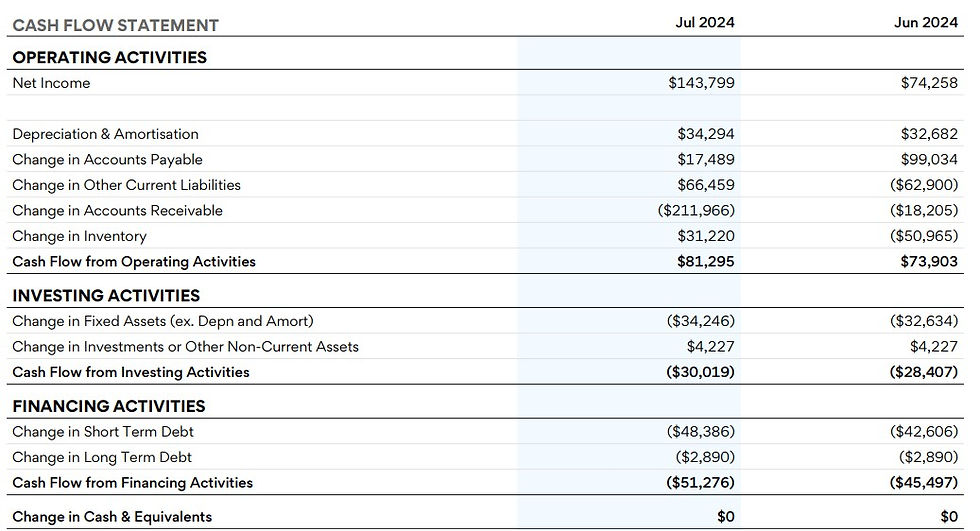Understanding Cash Flow: A Beginner’s Guide to Mastering Your Business Finances
- Colin Murray

- Jan 15
- 4 min read
Updated: Jan 30

Have you ever been surprised by a depleted bank account, even though your sales look strong?
You’re not alone. Many small business owners struggle to understand why profit doesn’t always equal cash in hand. It can feel frustrating and confusing, but the answer lies in one essential concept: cash flow.
Cash flow is the lifeblood of your business. Without it, you can’t pay bills, invest in growth, or weather unexpected challenges.
In this beginner-friendly guide, we’ll break down what cash flow is, why it matters, and how you can manage it effectively to keep your business financially healthy.
What is Cash Flow?
The Basics of Cash Flow
Cash flow refers to the movement of money in and out of your business. It’s not just about what you’ve earned (revenue) or what’s left after expenses (profit) but the actual money available in your bank account to use right now.
There are two main components:
Inflows: Money coming into your business, such as sales revenue, loans, or investments.
Outflows: Money leaving your business, such as rent, salaries, utilities, and inventory costs.
Analogy: Think of cash flow as the fuel in your car. Even if you’re driving a profitable business, without enough fuel (cash flow), you’ll eventually come to a stop.

Why Cash Flow Matters
The Importance of Liquidity
Liquidity refers to your ability to cover short-term obligations. Cash flow ensures you can pay your bills on time, keep operations running smoothly, and avoid unnecessary stress.
Example: A bakery generates $50,000 in sales one month but struggles to pay suppliers because customer payments haven’t arrived. This shortfall can jeopardize operations.
Cash Flow vs. Profit
It’s essential to understand the difference between cash flow and profit:
Profit: What’s left after deducting expenses from revenue.
Cash Flow: The movement of money in and out of your business at any given time.
Example: A retail shop may show a $10,000 profit for the month but experience cash flow issues if customers haven’t paid invoices yet.
The Risks of Poor Cash Flow Management
Without proper cash flow management, businesses can face:
Missed payments to vendors.
Damaged relationships with suppliers.
Limited ability to seize growth opportunities.
Increased reliance on costly credit.
How to Analyze Cash Flow
Key Components of a Cash Flow Statement
A cash flow statement is a financial document that shows how cash moves in and out of your business. It’s divided into three sections:
Operating Activities: Day-to-day inflows and outflows, such as sales revenue and expenses.
Investing Activities: Cash spent on equipment, property, or investments.
Financing Activities: Loans received, debt repayments, or dividends paid out.
By reviewing this statement, you can pinpoint where your cash is going and identify areas for improvement.
Metrics to Monitor
Here are three essential cash flow metrics to track:
Cash Flow from Operations (CFO): Measures the cash generated from regular business activities.
Free Cash Flow (FCF): The cash available after covering operational and capital expenses (equipment purchases).
Net Cash Flow: The overall change in cash over a specific period.

Tips for Managing Cash Flow
Forecasting Cash Flow
Forecasting helps you anticipate cash inflows and outflows for the next 3-6 months.
Example: If you know a large supplier payment is due in March, you can adjust February’s spending to ensure sufficient funds.
Strategies for Improving Cash Flow
Shorten Payment Terms: Request quicker payments from clients (e.g., net 15 instead of net 30).
Negotiate Vendor Terms: Ask for extended payment terms to align with your cash inflows.
Cut Unnecessary Expenses: Review and reduce costs that don’t add value.
Build a Cash Reserve: Save at least three months of operating expenses.
Use a Line of Credit: Secure access to funds during slow periods or emergencies.
Tools for Cash Flow Management
Leverage financial tools to simplify cash flow management:
QuickBooks Online: Tracks inflows, outflows, and upcoming payments.
Cash Flow Apps: Automate forecasting and generate insights.
Automated Invoicing Systems: Ensure timely payments from customers.
Common Cash Flow Mistakes and How to Avoid Them
Top 5 Mistakes
Confusing Profit with Cash Flow: Don’t assume a positive profit means healthy cash flow.
Ignoring Unpaid Invoices: Outstanding invoices delay cash inflows.
Overestimating Future Inflows: Be realistic with your projections.
Failing to Account for Seasonality: Anticipate slower periods and save accordingly.
Not Having a Cash Reserve: Lack of emergency funds can lead to financial stress.
Practical Solutions
For each mistake, implement a simple fix:
Use automated reminders for overdue invoices.
Create conservative cash flow forecasts.
Build a seasonal budget to manage fluctuations.
Set aside a percentage of monthly revenue for a reserve fund.
Conclusion
Understanding and managing cash flow is critical for small business success. By analyzing your cash flow, planning ahead, and implementing smart strategies, you can avoid common pitfalls and ensure your business thrives.
Key Takeaway: Even small steps toward cash flow management can make a big difference. Start today by reviewing your cash flow statement and identifying areas for improvement.
Stop Scraping By
Feeling overwhelmed by cash flow management? HighRidge CFO helps small businesses take control of their finances.
Contact us today to get started!




Comentários